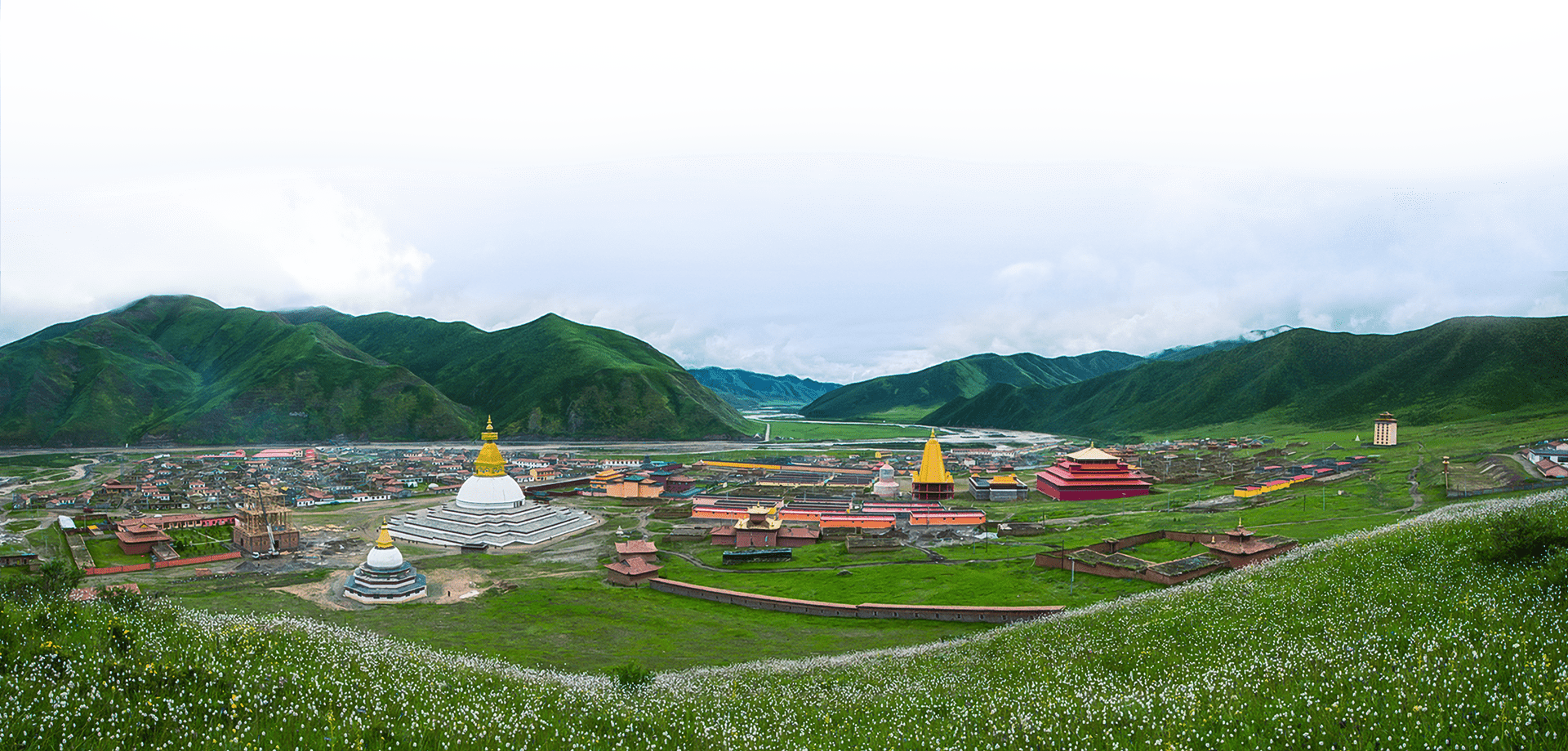An Examination of the Present State of Tibetan Art
Scholars, officials and friends,
The outer, inner and secret splendor of Tibet becomes brighter with each day in this world. Gradually, the people of this world are becoming more and more aware of the unique qualities of Tibetan culture. An ever-increasing number of people from all nationalities are studying and researching Tibetan culture and religion both generally and in specific details. Tibetan culture and religion are deepening the power of contemplation and study and bring peace to the mind.
This is the first conference on art held in Tibet to which scholars from everywhere and many skilled and famous artists have been invited to discuss the condition and development of Tibetan art. This is an auspicious event for the vitalization of Tibetan arts.
As for myself, although I love Tibetan art, I am not a trained artist and have only a little experience practicing it. Nevertheless, I am deeply grateful to be invited to this conference and to have this opportunity to talk about the present-day condition of Tibetan art.
I have seen many examples of art in various countries and I have developed a deep interest in them, and I have enjoyed doing a little research on the beauty of their arts and especially how different countries highly value their art.
What is the essence of Tibetan art?
Tibetan art has a long history and many forms, but throughout the world in general and throughout the breadth of our motherland, there is a particular fascination with and high regard for the art of the thangka. The essence and the value of Tibetan art lies in the skill of creating thangkas and representing the Buddhist deities. This has a worldwide interest and so it is the essential core of Tibetan culture, and the very essence of thangka painting is the representation of Buddhist deities and not representations of landscapes and animals. For example, in the art of Rebkong, horses don’t look like horses and donkeys don’t look like donkeys, so you can’t tell if an animal is a horse or a donkey. Similarly, they cannot differentiate between dogs and wolves. When it comes to flora, they are also unable to represent specific trees or flowers. Also they cannot portray the distinguishing features of men or women apart form hairstyles and clothes.
An American artist friend once said to me that in the past Japanese artists painted tigers as unthreatening pussycats, because they’d never seen what a tiger looks like, which makes you wonder if Rebkong artists paint horses to look like donkeys because they’ve never seen a horse! Just kidding.
Is Buddhism important in thangka art?
Without the paintings of Buddhist deities in Tibetan art the world would not be interested in other forms of our art. Therefore, the esteem of Tibetan art depends on this thangka tradition. Tibetan lamas and tulkus have been spreading Buddhism throughout the world and in doing so have introduced people to Buddhist deities. Therefore, wherever Buddhism in general and especially the Tibetan tradition in particular has been introduced there is great interest in thangkas. There are many people who then buy thangkas as an aid to their meditation or as to serve as the object of their offerings. The key factor that makes a thangka valuable for these people is that a lama has blessed it. Therefore, it’s not only through the skill of Tibetan artists that thangkas are sold in great numbers and have gained a worldwide renown, because this has been primarily the result of the activity of Tibetan lamas and tulkus.
What is the present condition of Tibetan art?
The Tibetan tradition of religious art is in great danger of falling prey to commercialism. Throughout the past, from the earliest times, artists had to have a good motivation and learned primarily through learning from teachers who held the transmission of deity painting. The artists held the view that their work was a way of generating merit and bringing blessings. That is why they painted the deities and taught this skill to others. The principal factor in creating the painting of the deity is the grid of proportions, and the representation of the face, the hands and the body. The foundation for the painting is the pure motivation of the artist. When the painting is complete in all details, it is blessed and consecrated and this enables it to bring great benefit to others.
However, present-day artists are motivated by profit and spend little time in receiving the transmission. They do not consider it important that painting be perfect in all its details, a proper representation of the deity with all the correct proportions. Instead, they concentrate on adding flowers and all kinds of fussy designs on the clothing, so that sometimes that is the entire day’s work that they have to show to the buyer. The result is that paintings by most contemporary artists end up looking like ugly people dressed in beautiful clothes.
The way in which contemporary artists paint and sell thangkas
There are Chinese and Western businessmen, who although they know about thangkas, lack the experience of evaluating the form of the drawings. In particular, they base their purchases of thangkas purely on whether they will make an impression on customers or not. There are artists who have gained some renown who don’t even touch their paintings but have their pupils paint them. Although they are representing an important deity, they disregard the importance of its color, insignia, and adornments but pretend it’s a perfect painting as long as it is colorful enough.
I once saw, in the possession of a Chinese businessman, a painting of a wrathful nine headed eighteen-armed deity, in which the deity had eight left arms and ten right arms! This was the result not of ignorance or intention, but because the artist had not taken seriously his responsibility in making the painting.
For example, there are paintings of Tsongkhapa and Guru Rinpoche made by artists with some renown, where the seats they sit on and the hats they wear are not in proportion. Did Tsongkhapa and Guru Rinpoche really have such big heads? Then, when we examine thangkas that portray an assembly of the deities, we find some of them have six fingers, some only four fingers, some with one big eye and one small eye; some who are not holding their insignia or are holding the wrong one! We can also find a big difference in quality between the main painted image and the surrounding deities, and so on. However, people of other nationalities are impressed by the thangkas because they don’t know anything about the importance of the proportions or the hand-held insignias.
It appears to me that many artists have fallen under the temptation to sound clever and pretend to be wise. The primary purpose of a thangka is to engender faith in the Dharma and respect for the Buddha. If the thangkas are blessed and consecrated, they will have the power to affect the mind. However, there are some artists who appear to have forgotten that they are only involved in business and they pretend to have high realization and like to give the impression that they are important Buddhists. They declare that their own paintings have more blessing than anyone else’s or that the images on their thangkas formed spontaneously. They like to give themselves high praise. Then there are those who say that karma is important but do that just to get customers.
For example, I’ve heard that around Kumbum monastery there are some merchants who take advantage of their Chinese brethren’s faith in the Dharma. They sell them kattas for some thousands of yuan each, saying that lamas have blessed them. Similarly, we see our Chinese brethren being deceived in the sale of thangkas. In one way we can see this as being a powerful karmic cause for them, but in another way it is a sign of ignorant faith and that they are easy to exploit.
What harm can come from the present state of Tibetan art?
I believe that the present state of the tradition of Tibetan thangkas will prove very deleterious for its future for the following three reasons:
1. If the ultimate motivation behind the making of thangkas is to make money, then the quality of the art will decline.
2. The quality of training in Tibetan art will not be preserved and its genuine transmission will go into decline.
3. The material greed of artists and their deception of customers will inspire disillusionment in both Tibetans and Tibetan art.
For example, I have heard and witnessed myself how there have been many people of other nationalities who in the beginning had faith in the Tibetan Dharma but became disillusioned on seeing the behavior of some Tibetans that was clearly contrary to the teachings of karma. In the end they became skeptical and developed a negative view of the Dharma, so that they threw their thangkas, and so on, into the garbage, or developed an antipathy towards Tibetan art.
How can we preserve the value of Tibetan art?
Tibetan thangka painting has presently gained some value and status in the world. In order to both preserve and increase that, so it can continue to be a genuine tradition that brings happiness to people all over the world, it is very important for the artist to have a pure motivation and to act in accord with the nature of karma. Art is indicative of the extent of training, confidence, learning, and heart, so therefore these things are revealed to others through one’s art.
This artistic tradition also expresses the thinking of the Tibetan people in general and it indicates having received the transmission of the Buddha’s teachings. It is important that monks who are artists be aware that they are working in accord with the true nature that is taught in the Dharma and that they are thereby representing the qualities of the Tibetan religion and the people.
Therefore, I appeal to you, again and again, to do what you can to help raise the motivation and conduct of this tradition that can be beneficial to all.
Finally, I express my heartfelt gratitude for these conferences in general and in particular this first conference on Tibetan arts, which are based from the beginning, through the middle to the end on the motivation of accumulating merit in friendship. I pray that these conferences will continue to progress and that Tibetan art will spread throughout the world and brings fulfillment to everyone.









